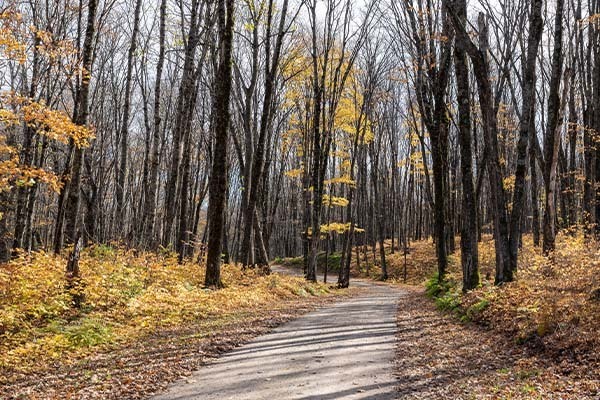Habitats
Habitats

UNDERC offers unique habitats for conducting environmental research. This center provides excellent opportunities to enhance our understanding of natural and human-altered environments that translate into better management and policies.
Forests
Forests at UNDERC are Northern mesic hardwood forest that is mostly second-growth consisting chiefly of aspen-birch, pine, or swamp-conifer with some red or sugar maple-hemlock.
Natural Disturbance: Wind
- Downbursts and tornadoes.
- Locally high winds cause downbursts among the trees in an area create gaps in the canopy that range in size from several miles to several yards in diameter.
- Fires frequently follow such wind destruction further modifying the environment.
Successional Differences
- Aspen and birch are pioneer species on the property that often colonize after windthrows or fires.
- A stand of aspen serves as a shelter crop for more shade tolerant species that can grow under a full canopy such as white pine, red or sugar maple and hemlock.
- The path of succession is affected by many factors including the frequency of disturbance and seed availability so a complete and predictable series is rarely, if ever, attained.
- Trees commonly encountered at UNDERC include the following
- Early successional
- Quaking Aspen (Populus tremuloides)
- Eastern White Pine (Pinus strobus)
- Red Pine (Pinus resinosa)
- Paper Birch (Betula papyrifera)
- Late successional
- Red Maple (Acer rubrum)
- Eastern Hemlock (Tsuga canadensis)
- Yellow Birch (Betula alleghaniensis)
- Sugar Maple (Acer saccharum)
- Balsam Fir (Abies balsamea)
- White Spruce (Picea glauca)
Wetlands
UNDERC supports a large number of wetlands. These areas are important not only because they occupy a large portion of the land area, but also because they satisfy many other functions, including nutrient cycling, storage and regulation of water flow, and primary production. There are three main types of wetlands at UNDERC: bogs, shrub carrs, and marshes.
Bogs
- Characterized by acidic conditions and are often surrounded by tamarack (Larix laricina) and black spruce (Picea mariana).
- Floor is covered by a thick layer of sphagnum moss (Sphagnum spp.).
- Sphagnum can also form floating mats, held together by roots of ericaceous shrubs, such as cranberry (Vaccinium spp.), Labrador tea, leatherleaf (Chamaedaphne calyculata), and bog rosemary.
- Other bog plants include orchids, and predatory plants such as pitcher plants (Sarracenia purpurea) and sundews (Drosera rotundifolia).
- Dead plant material (peat) accumulates reaching several feet in thickness and forming the base of the bog.
- Decomposition is extremely slow because of the lack of oxygen and the antibacterial properties of sphagnum.
Shrub Carrs
- Shrub swamp containing dense thickets of evergreen or deciduous shrubby species.
- Dominated by alders (Alnus incana) that are important in the nitrogen cycle as they fix nitrogen in their roots and thus replenish this often limiting nutrient in the soil.
Marshes
- Characterized by soft-stemmed plants such as cattails, grasses, and sedges.
- Soils can either flood periodically or constantly be saturated with water.
- Also support a host of submergent and emergent aquatic macrophytes in areas of open standing water.
- Often form along the borders of lakes or streams.
Lakes
Bathymetric Maps
-
These bathymetric maps were compiled from a variety of sources.
-
Morphometric parameters shown on the maps include:
- Maximum length (I)
- Surface area (A)
- Length of shoreline (L)
- Shore development (DL)
- Lake maps available:
- Bay Lake
- Bergner Lake
- Bog Pot Lake
- Bolger Bog
- Brown Lake
- Crampton Lake
- Cranberry Lake
- Eds Bog
- Forest Service Bog
- Gilbert Lake
- Gillen Lake
- Hummingbird Lake
- Inkpot Lake
- Kickapoo Lake
- Kinwamakwad (Long) Lake
- Moccasin Lake
- Morris Lake
- Mullahy Lake
- Nansen Lake
- North Gate Bog
- Paul Lake
- Peter Lake
- Plum Lake
- Reddington Lake
- Raspberry Lake
- Roach Lake
- Tender Bog
- Tenderfoot Lake
- Tuesday Lake
- Ward Lake
- Ziesnis Bog
Chemical Information
The attached appendix on individual lake chemical and biotic information (1.2 MB) is an alphabetic guide to a great majority of the lakes on the UNDERC property. Each entry includes a brief description of the body of water and its chemistry. Chemical data have been summarized from data collected since 1975. While the vernal ponds of the property have been mapped, they are not included in this guide.
Water chemistry data are self-explanatory. They were obtained by running replicated samples using Hach water chemistry kits (Hach Company, Loveland, Colorado). Samples not in agreement within 5% were discarded. Unless otherwise stated, alkalinity was determined by the total inflection method and color was read at 440 nm.
Plankton lists are provided for each body of water and provide genus name only. Each list is not complete, but rather offers a representative sample of the most abundant phytoplankton and zooplankton. Where applicable, a literature reference describing research on the lake is included.